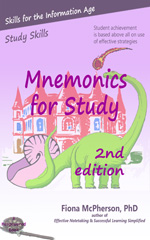Guide to Use
- Very effective for learning the meanings of words
- Not particularly effective for remembering the words themselves
- Most effective when you are supplied with the keyword, but create your own image
- Particularly suited for learning:
- vocabulary
- face-name associations
- core facts
How the keyword method works
The keyword method has been especially pushed as an effective strategy for learning foreign vocabulary. It is presumably equally valuable for extending your native-language vocabulary and learning technical jargon, and has also been used successfully to teach social studies facts (e.g., the products of a country; capital cities), science facts (e.g., chemical reactions, parts of the skeletal and nervous systems) and the names and faces of people.
There are two stages to the method:
- link the foreign word with an English word that sounds like some part of the foreign word (e.g., the Spanish carta sounds like the English cart). This (cart) is the keyword.
- link the keyword with the English meaning of the foreign word by forming an interactive image (e.g., carta means letter, so you could visualize a letter inside a cart).
When not to use the keyword method
If you want to understand what a word means when you come across it the keyword method is probably the best memory strategy. However if your goal is an ability to produce the word, rote repetition is better. In other words, your letter in the cart will help you remember what carta means when you come across it, but it won’t necessarily help you recall the Spanish word for letter.
Similarly, if you learn that Canberra is the capital of Australia by visualizing a can on top of a map of Australia, you should find it easy to answer “What is Canberra the capital of?”, but less easy to answer “What is the capital of Australia?”.
Remembering backwards
Although the keyword component of the word is much more likely to be recalled (the cart part of carta; the can part of Canberra), any word with that component seems equally possible.
To remember that carta means letter you need to:
- Derive the keyword from the word (cart from carta).
- Derive the interactive image from the keyword (letter in cart from cart).
- Derive the meaning from the image (letter, from letter in cart).
Clearly, the more obvious your original encoding, the easier it will be to recreate the process (cart is an obvious keyword for carta; pet is not quite so obvious for pequenos).
However, to remember the Spanish word for letter, you must:
- Retrieve the interactive image (letter in cart, from letter).
- Use the image to derive the keyword (cart, from letter in cart).
- Use the keyword to derive the foreign word (carta from cart).
While carta might seem easily derived from cart, other associations are not likely to be so easy — imagine trying to derive pequenos from pet or peck.
The keyword method is very effective for linking a new fact to a well-learned fact, but is little help in recalling the new fact itself.
Learn faster not better
The main advantage of the keyword mnemonic over other strategies for remembering information of this type, is that you acquire the information faster. But not better. Learning new words in a meaningful context is an equally effective strategy for long-term recall.
Read more:
Retrieval practice & the keyword mnemonic
- Belleza, F.S. 1983. Mnemonic-device instruction with adults. In Pressley, M. & Levin, J.R. (eds.) Cognitive strategy research: Psychological foundations. New York: Springer-Verlag.
- Pressley, M., Levin, J.R., Hall, J.W., Miller, G.E. & Berry, J.K. 1980. The keyword method and foreign word acquisition. Journal of Experimental Psychology: Human Learning and Memory, 6, 163-173.
- Wang, A.Y. & Thomas, M.H. 1995. Effect of keywords on long-term retention: help or hindrance? Journal of Educational Psychology, 87, 468-475.
